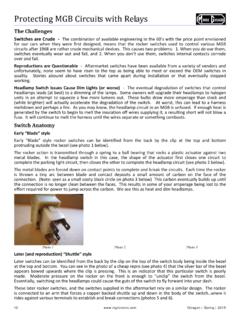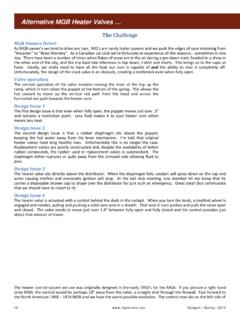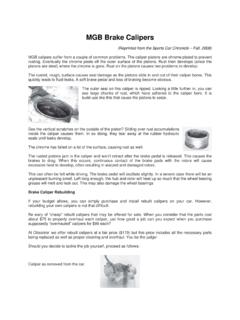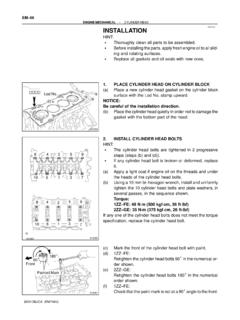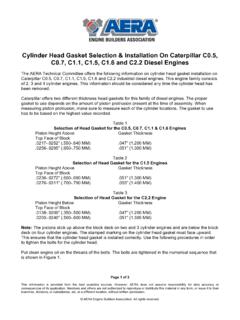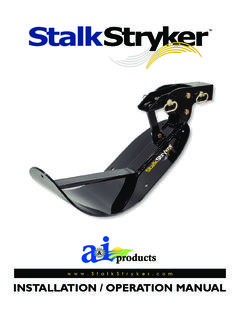Transcription of MGB Brake Master Cylinder - MGCCT | Toronto MG Car Club
1 MGB Brake Master Cylinder Rebuilding (Reprinted from the Sports Car Chronicle Summer, 2008) Early cars, those from 1963 until late 1967 use a single circuit braking system. Master cylinders for these cars are quite simple. It is easy to identify this early MGB braking system. Looking at the Master Cylinder , you will see the proverbial Tin Can fluid reservoir on the body of the Cylinder . This type of Cylinder is easier to rebuild than later tandem type cylinders, but only if it is in good enough condition! Though rebuilding the single Cylinder is less complicated, a failed overhaul can have catastrophic consequences. MGB braking systems were updated with a tandem Master Cylinder in 1967, and for good reason.
2 The tandem braking arrangement of 1967-1980 MGBs is inherently safer than the earlier single circuit arrangement. With the tandem system, there are two entirely separate braking circuits in the car. The forward portion of the Master Cylinder supplies fluid pressure to the rear brakes while the rear part of the Cylinder supplies fluid pressure to the front brakes. Both systems are totally independent. Should a fluid leak develop in either braking circuit, partialbraking will still be available from the other, un-affected Brake hydraulic circuit. Remember, in an early MGB with single circuit braking (most 1963-1966 cars) even a tiny leak anywhere in the braking system will result in a total loss of braking.
3 Though the parking Brake will still function, anyone who has suffered a braking emergency can tell you that it is grossly inadequate. Trying to stop from high speed, by means of the parking Brake only, will prove to be a perilous experience. Don t fool with the braking system. Both your life and the large investment in your MG are at stake! Signs of impending Brake trouble are usually obvious. Things like a soft Brake pedal, or taking unusually long to stop are good indications of trouble. At the first sign of trouble, do what ever is necessary to bring your brakes back to good health. Check the fluid level in the Master Cylinder reservoir. Keep in mind that slight fluid level dropping in an early car (63-66 with single circuit brakes) or in the front reservoir section only, in a later car with tandem brakes, is normal due to front Brake pad wear.
4 As the pads wear down, the caliper pistons extend further out of their bores in the caliper to compensate. Consequently the fluid volume inside the calipers becomes larger. However, this change will occur slowly, over many months of driving. Any sudden, or substantial loss of Brake fluid indicates a leak, which must be attended to at once. In the case of 1967 and later cars (with tandem Master Cylinder ) no fluid loss in the front segment of the Master Cylinder reservoir is acceptable. Any loss of fluid here indicates a leak. Diagnosing Brake hydraulic trouble is relatively easy. Examine all four corners of the car, looking for fluid leakage. Look for obvious leaks as well as damp spots on or around the Brake calipers, wheel cylinders, rubber hoses, and steel pipes.
5 Also, look up underneath the dashboard, where the pedals protrude from the pedal box above. A badly leaking Master Cylinder will drip Brake fluid down into the cockpit area, around the pedals. If this rudimentary check locates the trouble, all the better. The leaking component can be overhauled/replaced and the brakes then bled. One possible Brake malfunction that has yet to be mentioned is Master Cylinder failure caused by bypassing . When this occurs, Brake fluid leaks past either the primary or secondary piston seal in the Master Cylinder . Often the Brake fluid then leaks back into the Master Cylinder reservoir.
6 In this instance, the fluid level in the Master Cylinder may not drop at all, while at the same time the brakes will still not operate properly. Once you have eliminated the other Brake hydraulic components, a suspect Master Cylinder must be removed from the car for internal inspection. Unfortunately, removing the Master Cylinder from an MGB is not much fun! Cars from 1963-1974 have both the Brake & clutch Master cylinders mounted side by side on the pedal box. Removing the Master Cylinder will require that two bolts (difficult to get at!) are removed. These bolts secure the Master Cylinder mounting flange to the pedal box front face.
7 1975 and later cars are equipped with a vacuum servo ( Brake booster). This provides some pedal assist, but more importantly from a service standpoint, allows much easier removal and installation of the Master Cylinder . In the case of these later cars, the Brake Master Cylinder is simply bolted onto the end of the Brake servo. Removal is simply a matter of undoing two nuts off of the servo studs and then the Master Cylinder can be slid off. The Brake pipe(s) attached to the Master Cylinder must also be disconnected. NOTE: Just prior to unscrewing the Brake piping, siphon as much Brake fluid out of the Master Cylinder reservoir as possible. This will reduce the amount of Brake fluid that spills out during disconnection/removal.
8 Remember, Brake fluid eats paint! After removal from the car, unscrew the reservoir cap and dump the remaining fluid out of the Master Cylinder . Since the most populous MGBs in existence are the 67-74 models with tandem Master Cylinder , this is the model that we will detail in this tech. article. The plastic reservoir should be removed from the Cylinder body. It is secured with four Phillips head screws, accessible from underneath. You will note that there are two rubber O-ring seals, which seal the reservoir against the Cylinder body. These O-rings are occasionally responsible for fluid leaks. Reservoir removed showing O-ring seals.
9 The next job is somewhat unpleasant. After removing the big rubber boot off the push rod end of the Cylinder , a top hat shaped steel sleeve and large coil spring will be plainly visible. Both these components surround the end of the primary piston. The sleeve will need to be pushed down, compressing the coil spring, while a special type of circlip is being removed. A Spirolox circlip holds this top hat shaped sleeve onto the primary piston. The circlip is made up of thin flat spring steel. It must be prized up out of its groove in the primary piston and carefully unwound . Take care not to damage it since it is not separately available and must be re-used.
10 After the Spirolox clip is removed, the sleeve and coil spring can be slid off the end of the primary piston. Nothing like a little improvisation! Here an assistant is using two special factory service tools (flat files) to hold down the spring, allowing Spirolox circlip removal. Down inside the exposed end of the Cylinder bore will be found a conventional type circlip. This must now be removed. Pen point shows the first conventional circlip, about 3/8 down the Cylinder bore. You can also see the white nylon guide bearing behind it. Located behind the circlip that you just removed is a white nylon guide bearing. It is a tight fitting nylon bush, which supports and guides the primary piston as it slides in and out of the Master Cylinder bore.
